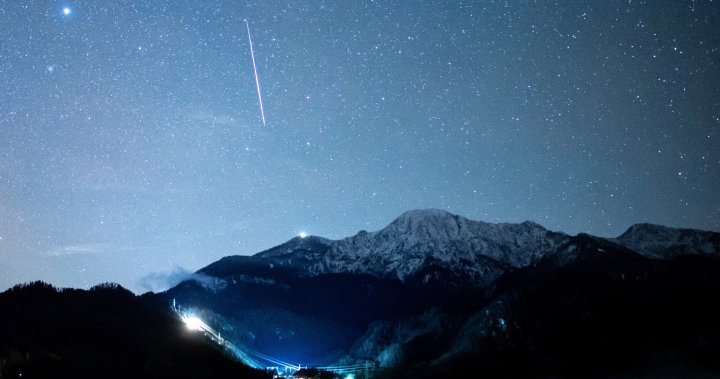Stargazers are getting ready to witness one of the “most active and reliable meteor showers” of the year light up the skies this week.
The Geminid meteor shower is expected to peak on Thursday but could be visible starting Wednesday night.
The annual spectacle brings a flurry of so-called “shooting stars” streaking through the skies, delivering a meteor as often as one per minute.
Each year, there are six major meteor showers, but the Geminids is considered to be “one of the best and most reliable,” according to NASA.
“Even if you only see one or two meteors, it’s probably something you’ve never seen in your life before, so it’s one of those things that you can check off your bucket list,” John Percy, professor emeritus of astronomy and astrophysics at the University of Toronto, said in an interview with Global News.
But if the sky is perfectly clear and you’re away from city lights, you could end up seeing “100 or more meteors” per hour, he said. “That’s pretty spectacular.”
The Geminid meteor shower comes from the asteroid 3200 Phaethon and the constellation Gemini is its radiant, or point of origin.
Photo taken on Dec. 13, 2021 shows the star trails at the Yulong Snow Mountain in Lijiang City, southwest China’s Yunnan Province. (Image achieved by stacking multiple exposures).
Credit Image: © Jiang Wenyao/Xinhua via ZUMA Press
A meteor shower occurs when many meteoroids or space rocks coming from comets and asteroids collide with the Earth’s atmosphere all at once.
When these particles get close to the Sun, they get extremely hot and leave a dusty trail of debris.
So each year as the Earth orbits around the Sun, it also passes through the debris, which quickly burns up when it strikes the upper atmosphere, releasing a glowing streak of hot air.
It takes about one second for a meteor to zip through the sky and convert its energy of motion into the glow of air molecules, Percy said.
“They create a streak in the sky that lasts for maybe a second or two,” he said.
That might give it the illusion of a “shooting star,” but Percy said in reality this has “absolutely nothing” to do with stars and what you’re looking at is basically space dust coming through the atmosphere.

What will the Geminid meteor shower look like?
The Geminid meteors are bright, fast and typically yellow in colour, according to NASA.
At its peak, 120 meteors can be seen in one hour, the space agency says on its website.
They travel at the lightning-fast speed of 127,000 kilometres per hour.
“Because the nights are twice as long as they are in the summer, you do potentially have the opportunity of seeing many more meteors,” Percy said.
“Another good thing about this year is that the moon is very close to being new, so it’s not going to provide a huge amount of light in the background sky like it might if it was a full moon.”
A shooting star can be seen during the Geminid meteor stream in the starry sky above the Kochelsee and the summit of the Herzogstand early Monday, Dec. 14, 2020.
Matthias Balk/dpa via AP
How can you watch it in Canada?
There is no need for a telescope or pair of binoculars to get a glimpse of the Geminid meteor shower.
All you need to do is grab a warm blanket and maybe a sleeping bag, lie down outside and look up at the sky.
The best time to catch it is at night and before dawn.
Depending on where you are, the shower usually starts around 9 or 10 p.m., NASA says.
A Geminid meteor shower streaks across the night sky on the early morning of Dec. 12, 2021, in Bazhou, Xinjiang province, China.
Xue Bing / Costfoto/Future Publishing via Getty Images)
Because it gets so dark so early in Canada, you might even see one as early as 6 p.m., Percy said.
“Generally, it’s better after midnight because then the Earth is pointing in the right direction in space (and) also, the lights tend to be a bit lower after midnight,” he said.
To get a good view, Percy advised finding an area well away from the city lights or if you can’t drive out to the country, then a safe local park is another option.
The clearer and darker the sky the better the spectacle.
To avoid hurting your night vision, try not to look at your cellphone or other lights during the meteor shower, says an article in The Old Farmer’s Almanac, which tracks lunar events.
“It’s always a good idea if you’re going to do some serious stargazing to let your eyes acclimatize outside to the dark for 15 or 20 minutes, and then your vision for fainter objects does improve significantly,” Percy said.
While the peak of the Geminid meteor shower only lasts a couple of days, the total duration is much longer.
This year’s Geminid meteor shower began on Nov. 19 and is expected to remain active till Dec. 24.
© 2023 Global News, a division of Corus Entertainment Inc.




